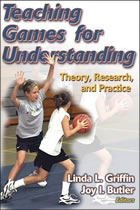EDITORIAL
Open
Source PE Lessons: Let's Share the Wealth!
 "Open
source" is a phrase familiar to the technology
community. Open source advocates believe that
better outcomes can be achieved through broad
cooperation. This includes the free sharing
of knowledge and resources. Open source thinking
exemplifies the TEAM approach: Together everyone
achieves more. The downside of this approach
is that some people risk receiving less for
their achievements. Not surprisingly, for
the talented this can be a rather unattractive
option. So what does this have to do with
physical education? Everything, especially as we try to elevate the quality of our teaching and remain relevant in 21st century public education. "Open
source" is a phrase familiar to the technology
community. Open source advocates believe that
better outcomes can be achieved through broad
cooperation. This includes the free sharing
of knowledge and resources. Open source thinking
exemplifies the TEAM approach: Together everyone
achieves more. The downside of this approach
is that some people risk receiving less for
their achievements. Not surprisingly, for
the talented this can be a rather unattractive
option. So what does this have to do with
physical education? Everything, especially as we try to elevate the quality of our teaching and remain relevant in 21st century public education.
Currently, thousands of American health and
physical education teachers wake up each morning
thinking about the lessons they will teach
that day. Some will turn to carefully crafted
lesson plans closely matched to meaningful
K-12 curriculums. Others will do what far
too many have always done: Make up instruction
on the fly. As disparaging as this remark
might sound it's easy to understand. Facing
a packed daily teaching schedule, who has
time to write quality lesson plans? Detailed
lesson planning for many teachers ends with
college graduation. Starting careers with
only novice instructional and classroom management
skills, lesson planning takes a backseat to
survival. And to survive it's a lot easier
to keep kids busy and active rather than to
attempt meaningful instruction.
It's pretty ironic that the most practice
teachers get planning lessons is during their
undergraduate preparation. This is when they
typically know the least about the wide variety
of curricula available for instruction. It's
when as PETE majors they personally possess
only a narrow repertoire of activity knowledge
and skills. Few have experience managing large
groups for instruction, or dealing with behavioral
issues. And at this time they know little
about how to break down skills for instruction,
design practice tasks, and give meaningful
feedback.
If this wasn't hard enough, what do we do
to make this already challenging environment
even tougher? We ask them to write lesson
plans usually on topics they know little about
and have never before attempted to teach.
Even worse, we assign this task to individuals
who for the most part did not choose to become
health and physical education teachers because
of their exemplary writing skills. It's a losing combination, and yet for years we've persisted doing it despite the fact that for many physical educators it will be their last lesson writing experience.
Here's where the concept of "open source"
makes sense in physical education. Some people
are capable of writing outstanding lesson
plans. Some people aren't. Why aren’t
we sharing, and having everyone use top quality
instructional resources? What's the point
of forcing people who are not good writers
or planners to create something destined to
fail? Surely it makes far more sense to spend the limited time we have with novice teachers helping them improve their practical teaching skills so that they can quickly move beyond survival teaching into meaningful instruction?
Unfortunately, as part of professional practice
we've come to accept "lesson planning"
as an inherent and essential teaching skill.
It isn't. Musicians don't design and build
musical instruments. Contractors don't design
buildings. Authors don't build the computers
they use to write books. What's important
to move physical education forward is that
teachers have access to top-quality lessons
and have the skills and knowledge to implement
them. Part of this skill set, of course, requires
the ability and sensitivity to know when and
how to modify and adapt lessons to meet student
needs. But this is entirely different from
developing and writing quality lesson plans.
If from the outset we put top quality lesson plans into the hands of PETE majors and novice teachers we'd greatly increase their chances of success. They'd quickly learn what meaningful instruction looks like and begin modeling it. When they step
into schools they'd have a framework to support
their instruction. The expectations of quality
physical education teaching would be quite
clear to them. Switching to the "on-the-fly" teaching method would be unnecessary because they'd immediately have high quality resources to guide their teaching.
There would be less of a reason
or justification for poor teaching or non-teaching.
The benefits of this approach would of course
go beyond simply helping out PETE or novice
teachers. All of us, at some time, find ourselves
novice teachers when challenged to teach an
activity or subject matter that is new to
us. Open source lesson sharing would help
us all. It would reduce our reticence to try
new things. Above all it would save countless
wasted and frustrating hours. But there's
more. Open source thinking is not limited
to enhancing public school physical education
teaching.
Similar scenarios to those described above
are endlessly repeated in today's physical
education professional preparation programs.
There are certainly far more similarities
than differences between the nation's PETE
programs. Nevertheless, teacher educators,
although occasionally aided by textbook authors,
devote hours to class preparation. In truth,
we aren't all equally as good at this task.
And the hours we spend planning lessons would
be far better spent with our students or on
service or research. It makes no sense. Faculty
devote an unfathomable amount of time to creating
classroom slideshow presentations. Many of
these are awful, not because of a lack of
trying but because our training never included
principles of visual design and delivery.
Consequently, we far too often perpetuate
"death by PowerPoint" experiences
often while simultaneously lecturing on teaching
effectiveness.
Open source thinking is an idea whose time
has come. Who wouldn't want access to some
of the brilliantly creative instructional
resources others have presented? Sign me up!
It's not even as if there is a huge market
for selling them. If we truly want to improve
the quality of physical education teaching
and justify our existence in tomorrow's public
schools, we need to work smarter. We need
to question traditional ways of doing things
and become more innovative in our thinking.
We need to find ways to be more generous in
our sharing. Helping others to teach better
benefits all of us. And teaching physical
education better is vital for our survival.
Steve
Jefferies, publisher pelinks4u
|














 "Open
source" is a phrase familiar to the technology
community. Open source advocates believe that
better outcomes can be achieved through broad
cooperation. This includes the free sharing
of knowledge and resources. Open source thinking
exemplifies the TEAM approach: Together everyone
achieves more. The downside of this approach
is that some people risk receiving less for
their achievements. Not surprisingly, for
the talented this can be a rather unattractive
option. So what does this have to do with
physical education? Everything, especially as we try to elevate the quality of our teaching and remain relevant in 21st century public education.
"Open
source" is a phrase familiar to the technology
community. Open source advocates believe that
better outcomes can be achieved through broad
cooperation. This includes the free sharing
of knowledge and resources. Open source thinking
exemplifies the TEAM approach: Together everyone
achieves more. The downside of this approach
is that some people risk receiving less for
their achievements. Not surprisingly, for
the talented this can be a rather unattractive
option. So what does this have to do with
physical education? Everything, especially as we try to elevate the quality of our teaching and remain relevant in 21st century public education.

